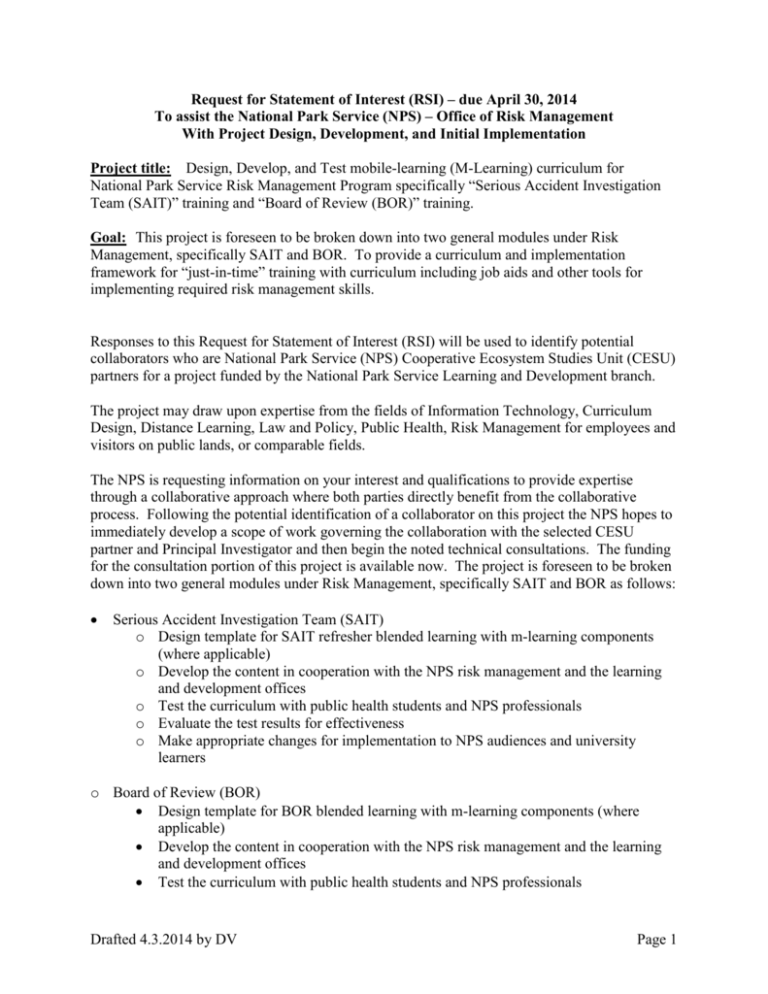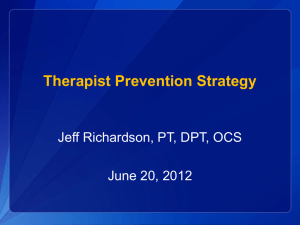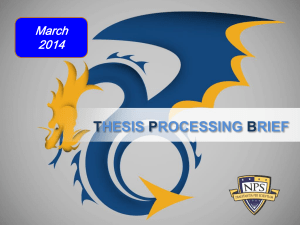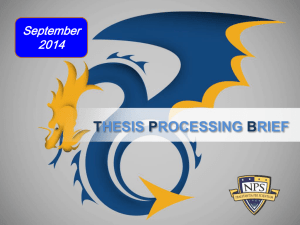Bryce Canyon Cultural Landscape Reports for Bryce Canyon Lodge
advertisement

Request for Statement of Interest (RSI) – due April 30, 2014 To assist the National Park Service (NPS) – Office of Risk Management With Project Design, Development, and Initial Implementation Project title: Design, Develop, and Test mobile-learning (M-Learning) curriculum for National Park Service Risk Management Program specifically “Serious Accident Investigation Team (SAIT)” training and “Board of Review (BOR)” training. Goal: This project is foreseen to be broken down into two general modules under Risk Management, specifically SAIT and BOR. To provide a curriculum and implementation framework for “just-in-time” training with curriculum including job aids and other tools for implementing required risk management skills. Responses to this Request for Statement of Interest (RSI) will be used to identify potential collaborators who are National Park Service (NPS) Cooperative Ecosystem Studies Unit (CESU) partners for a project funded by the National Park Service Learning and Development branch. The project may draw upon expertise from the fields of Information Technology, Curriculum Design, Distance Learning, Law and Policy, Public Health, Risk Management for employees and visitors on public lands, or comparable fields. The NPS is requesting information on your interest and qualifications to provide expertise through a collaborative approach where both parties directly benefit from the collaborative process. Following the potential identification of a collaborator on this project the NPS hopes to immediately develop a scope of work governing the collaboration with the selected CESU partner and Principal Investigator and then begin the noted technical consultations. The funding for the consultation portion of this project is available now. The project is foreseen to be broken down into two general modules under Risk Management, specifically SAIT and BOR as follows: Serious Accident Investigation Team (SAIT) o Design template for SAIT refresher blended learning with m-learning components (where applicable) o Develop the content in cooperation with the NPS risk management and the learning and development offices o Test the curriculum with public health students and NPS professionals o Evaluate the test results for effectiveness o Make appropriate changes for implementation to NPS audiences and university learners o Board of Review (BOR) Design template for BOR blended learning with m-learning components (where applicable) Develop the content in cooperation with the NPS risk management and the learning and development offices Test the curriculum with public health students and NPS professionals Drafted 4.3.2014 by DV Page 1 Evaluate the test results for effectiveness Make appropriate changes for implementation to NPS audiences and university learners Background, Overview, and Issues: The NPS under the Department of the Interior has requirements for processing employee and visitor fatalities. However, the training requirements and refreshers are sporadic and challenging to maintain for the highest quality of effectiveness. Attached are summary statements describing the current situation in both SAIT refresher training and BOR training. The issues relate to the umbrella of risk management, public health, team leadership principles and require a quick learn or quick refresher response mobilization when an incident presents itself. We anticipate developing several modules of blended learning that may include mobile learning components associated with applicable modules. We desire a collaborative academic design and development partnership to accomplish both the strategy for testing & evaluating, as well as implementation to learners. The training needs for SAIT include: SAIT Lessons Learned from case studies and examples demonstrating challenges, barriers, best practices, documentation for future lessons learned education. Refresher training on procedural steps, protocols, and regulation requirements (example: Timelines, documentation, team member roles and responsibilities, and final expectations required of the team). The training needs for BOR include: Goals and expectation of process Purpose of laws and policy related to BOR Differences and similarities between visitor and employee fatality Roles and responsibilities by park, region and national staff Steps, protocols and regulatory requirements for conducting a BOR And other ancillary benefits associated with a BOR Currently, the Washington D.C. Office of Risk Management under the directorship of Visitor and Resource Protection oversees the training and compliance of training and employee development through Instructor Lead Training (ILT). This request for statement of interest (RSI) is seeking an overarching proposal for this e-course design and development but will consider the sub-theme proposals as pieces of the whole project (in other words, individual proposals to the subthemes mentioned above). There is no funding available for proposal preparation, but the intent is to have those assisting in the proposal development serve as the Principle Investigator(s) for the project. The requested project proposal should include: Drafted 4.3.2014 by DV Page 2 development of the proposal introduction and background sections, including a project abstract and statement of project need; development of specific tasks and associated methodologies to be used in each of the project phases; development of timeframes for implementation of activities identified for each of the project phases; development of a detailed project budget that provides information on requested funds and any in-kind/matching contributions with the following six categories (a) Personnel Services Costs (Salary and Benefits), (b) Travel and Transportation Costs, (c) Supplies Costs (d) Equipment Costs, (e) Contractor/Cooperators Costs, and (f) Other Costs (including CESU overhead). Electronic Statement of Interest can be e-mailed to Sara_Newman@nps.gov and mailings or electronic media should be sent by Fed-ex to: National Park Service, Attention Office of Risk Management, Sara Newman 1201 Eye Street NW, Washington, D.C. 20005. Please submit electronic Statement of Interest by April 30, 2014. The effective date of the proposal will be September 1, 2014 to be completed by September 31, 2017. Personnel from the NPS Risk Management program will be available to answer questions or to provide guidance as needed. Primary point of contact is Sara B. Newman; phone 202-513-7225, Sara_Newman@nps.gov and secondary point of contact is Demmy Vigil, 304535-4023, Demica_Vigil@nps.gov . Materials Requested for Statement of Interest/Qualifications Please prepare a not to exceed 3 page summary of how you would envision such a collaborative project. Include your name, organization, and contact information, as well as information about any relevant experience, past projects, and staff, faculty, or students who would be available to work on the project. You may also include CV’s in your submission package and these are not included in the three page limit. Graduate students are welcome to work on this project under the supervision of the project Principle Investigator (s). Proposals that involve students from under-represented demographic groups will be well received. An initial budget not to exceed our total financing is $50,000 for this fiscal year ending September 31, 2014 and up to $150,000 for approximately three years total for the completion of the proposal. Each year we anticipate adding funding to this project. This funding includes the pre-determined 17.5% overhead. Please submit electronic statements of interest to Sara_Newman@nps.gov by close of business on April 30, 2014. Drafted 4.3.2014 by DV Page 3 Serious Accident Investigation Team Refresher Training - Brief VRP Division: Office of Risk Management Issue: Refresher Training for SAI Teams Date: June 27, 2013 Background: Departmental policy (DM485, Chapter 7) requires Bureaus to ensure that adequate administrative procedures, qualified personnel, and appropriate resources are in place to conduct serious accident investigations (SAI). The policy requires each bureau’s Designated Agency Safety and Health Official (DASHO) to authorize or appoint a Serious Accident Investigation Team (SAIT) or Trained Investigator (TI). The SAIT or TI must be promptly mobilized and on the ground within 48 hours of the accident. While NPS makes a concerted effort to meet these requirements, the agency currently uses a simple roster of trained employees to contact and select SAIT members. As evidenced by recent NPS SAIs, it often takes several days to identify and mobilize the members of the SAIT, delaying the start of the investigation process and possibly losing access to frangible physical evidence or witness testimony, as well as potentially failing to meet NPS and Department timeline requirements for initiation of the SAI. This also delays communication of critical and accurate information necessary to brief family members, co-workers, other NPS employees and managers, and the Office of the Director and the Secretary of the Interior. Although the roster of trained SAIT members have been through 40 hour training to prepare them for the requirements of the assignment, because there is commonly a delay between the initial training and an actual assignment, and the inability to provide shadowing opportunities for all trained staff, there is a need to provide interim or refresher training for SAIT members to ensure we have a roster of team members prepared with up to date and current knowledge that will prepare them to serve as part of a team when needed. Per DM485 and RM 50B, each SAIT is required to have the following qualified team members: a) Team Leader: Generally a Superintendent, Regional ARD-O or Chief Ranger or other NPS senior management official (GS-14 or above) from another region who has attended the DOI/USDA Interagency Serious Accident Investigation course and is responsible for all activities required to accomplish the objectives of the investigation. b) Chief Investigator: A person who by training and experience has the ability to manage a complex investigation and is responsible for the direct management of all investigative activities. The Chief Investigator must have completed investigation training and the DOI/USDA Interagency Serious Accident Investigation course. c) Safety and Health Advisor: A safety professional in his/her daily job who is responsible to the team leader for safety and health issues confronting or affecting the team, for specialized knowledge required for analysis of the causal factors, and a thorough understanding of the OSH Act and OSHA’s regulatory processes. Must have attended the DOI/USDA Interagency Serious Accident Investigation course or equivalent. d) Document Specialist/writer/editor: A person who by occupation or training is able to use software and hardware to collect, scan, distribute, save and organize evidentiary documents, develop the body of the report, transcribe notes from SAI team members Drafted 4.3.2014 by DV Page 4 into the report and otherwise facilitate the development of the Factual and Management Reports. e) Subject Matter Expert(s): A subject matter expert who is familiar with the duties, equipment or operation of the individuals involved, or is a SAIT trained investigator as appropriate. f) Additional supporting members as needed at different phases in an investigation: i. Technical specialists ii. Public Affairs Officer iii. Root cause analysis facilitator (can be contractor) Training Needs: 1. Lessons learned from SAITs: Case studies/examples of challenges/barriers 2. Role specific training 3. Refresher on steps to carry out a SAIT a. What are timelines b. What documentation is required c. What are the roles of the various team members d. What are the products required from the team Drafted 4.3.2014 by DV Page 5 Visitor Board of Review Training Project - Brief Office of Risk Management, Public Risk Management Program Background The implementation of Director’s Order #50C in May 2010 requires all parks to conduct a Board of Review (BOR) assessment for all visitor fatalities. Since then, however, only 55 BORs (11%) of 505 visitor fatalities have been submitted. Aside from the basic guidance and template provided in RM 50C Part III: Board of Review, park regions and staff have not received any official training on how to properly conduct a visitor Board of Review, why it’s important, and how it can help prevent future incidents. Furthermore, park staff may not realized that the visitor BOR process is much shorter and less demanding than the extensive process that is required of them when handling employee fatalities. Considering the burden of visitor fatalities is far greater than that of employee fatalities, it is unsurprising that park staff feel overwhelmed by this requirement. Based on an series of interviews conducted with park and regional chief rangers and regional safety officers to address concerns about low and inconsistent reporting, staff expressed a general lack of education, training, appropriate resources, and communication about the visitor BOR process. Delegation of responsibilities for initiating and conducting a visitor BOR is not always clear, and many expressed reservations about liability risks and FOIA concerns. Regional offices are not clear about their role in the BOR process or how they are to assist parks. NPS staff is often not aware of the policy, process, and expectations. Due to lack of training and support, most officials feel ill-equipped to pursue and complete the process. There is a strong need for a training initiative that can prepare NPS staff with the education, tools, and resources necessary to effectively complete the BOR process. Goals A BOR Training Program would demonstrate to NPS staff: The purpose of Director’s Order 50C and the goals and expectations of the BOR process The benefits of conducting a BOR to improve risk management processes in the park and to strengthen the discretionary function of the superintendent. How to differentiate between the processes used to address visitor fatalities and employee fatalities Clarify the regional and park roles in the BOR process How to properly and efficiently conduct a BOR How to write a BOR report Drafted 4.3.2014 by DV Page 6







